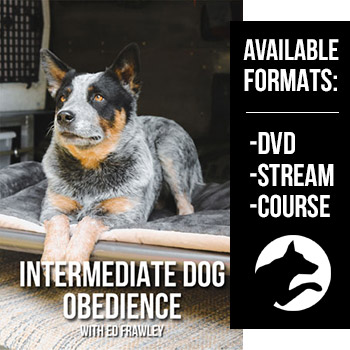Leerburg's Evolution into Online Dog Training

Back in 2009, I never thought we could have an interactive computer course where students could talk with instructors or use smartphones to upload their recorded training sessions to be critiqued by peers and the instructor. Through the development of Leerburg's online courses, however, all this has since come to pass.
When the video business switched from VHS tapes to DVDs, I thought it would take a couple of years for everything to switch to DVDs, but I was wrong—it happened in less than a year. I ended up with big racks full of commercial VHS duplicators that I took to the dump. I thought the same thing would happen with online training courses, but I was wrong again: this time, it's taking a little bit longer. This article is about how dog training has evolved since I went to my first Schutzhund (IPO) seminar in 1974. I bought my first video camera to film dog training seminars in 1978, then went on to sell dog training videos in 1982. When this period eventually ended, I moved on to our online dog training courses that we started to sell in 2014. Up until 2011, I never thought it would be possible to teach people to train dogs on their computers. I went through the VHS - Beta tape area, the S-VHS era, the Hi8 era, and then on to the CDs and DVDs. We started to stream our DVDs online back in 2011, but that was just a step above DVDs.
I first started to think the computer could be used to teach dog training with the addition of the “NOTES” feature. Our IT (we have 7 IT people that work at Leerburg) came up with that for our streaming videos. If you're not familiar with Leerburg's streaming videos, every stream has a “notes” feature. The cool thing about the notes feature is that a trainer can pause the streaming video anywhere they want and add a note on why they paused at that spot. They can post as many notes as they want in a streaming video, and the notes will always be there for them to reference later. Whether they come back after a day, a week, a year, or any other point in the future, all they need to do is click a note and the streaming video instantly starts to play from that spot. This means the trainer can essentially create their own outline of the streaming video content, then come back and review that material later with little to no work. One quickly realizes the value of this feature if they must find something in the middle of a DVD. Jumping back and forth to find a single five-minute clip in a DVD is frustrating and can take FOREVER-but finding content by using our notes feature is almost instant.
Now, back to the online courses. In 2009 and 2010, I started to get training questions from customers who would ask to email me videos of their dog working for reference. That made me start thinking about interactive computer learning. Universities had been using online learning for a few years at that point, with a company called Blackboard being one of the key players, so I asked my IT manager to check into leasing Blackboard (they don't sell their program outright). That led to a rude awakening when I found out that Blackboard wanted $12,000 a year to lease their software-and that was only for a 200-student license!
After that, we sat down and I tasked our IT staff with writing computer code for our own online learning management system (LMS). I put specific emphasis on video training-not just for the delivery of dog training videos as course content, but also as an important tool for students to easily upload and submit videos of their training directly from their computers, tablets, and smartphones. Our group of very smart and talented computer engineers started writing computer code in 2013 and we didn't publish our first course (my Basic Dog Obedience course) until February of 2014. That wasn't the end of their work, either-they have continued to improve and enhance the code since then, and we are still making plans for adding new features. There were a lot of hoops I insisted on jumping through before we finished, and like the note feature in our streaming program, those features have brought me to the realization that online computer learning has become a thing of the future.
We wanted to make this program work for as many people as possible, and since everybody's schedule is different, we offer both self-study and interactive classes for students to choose from. Here are just a few the features of we wanted in our program and the reasons I believe in them.
Our Interactive courses:
- Students have direct access to the instructors. They submit weekly forum questions that instructors answer.
- Students get homework assignments where the instructor may ask for a short, 3-5 minute video of themselves and their dog demonstrating specific behaviors related to that week's course content or training concepts. Our courses can also be accessed using any mobile device or tablet. The students simply go to that course's video forum, click one button to select the video they just filmed, and then click submit. Their training video is automatically uploaded into the forum for that week of the course. The instructor and other students can see and comment or offer suggestions. Seeing a variety of different videos benefits all the students in the class because they are exposed to so many different examples to learn from.
- Having a few years of experience with streaming videos by that point, it was important to me to be able to stream our videos at a variable bitrate. In normal English, this simply means we can automatically offer a higher quality version of the video to students with high-speed internet, and a lower quality version of that same video to students with slow internet (just a little faster than dial-up).
- We have our own cloud-based video web servers, so our system is all internal. This ensures our videos and our student videos are private-unlike a few competitors who use YouTube or Vimeo channels, which are not very private or secure.
What's cool is that we have 72 cloud-based web servers spread around the world that allow us to stream videos as quickly to trainers in other parts of the world such as South America, Israel, Europe, Australia, England, or Japan as we can here in America. Who would have thought that in 2010?
This has opened an entire world of potential dog trainers to our instructors. It also allows students who could not afford to travel to someplace like California to attend Michael Ellis's 16-week advanced course to take advantage of one of the smartest, most articulate dog trainers in the world today. Not a lot of people can afford to take 16 weeks off work and pay for hotels or apartments during that period, but because of our online training courses, those people now have direct access to Michael and his training. - Most of our instructors that offer interactive courses have live weekly “live chats”—which are essentially round-table video conferences. This means students in the class can log in, ask questions, and hear and see the instructor answer or comment on their questions in real-time.
- It is up to the instructor, but the instructor can offer certificates of course completion by having the students test out of courses. This is important to some new trainers.
- The difference between our interactive courses and our self-study courses is that self-study courses are much less expensive because there is limited or no interaction with the instructor. Still, these courses can contain far more information than a DVD (which is limited to 3-4 hours of training information). Some of our self-study courses contain over ten hours of video training. Not only that, courses can be updated to include new information at any time, and it only takes the instructor minutes to update course content. When that happens, enrolled students will automatically have access to the new, updated.
A perfect example of this is our first course, my Basic Dog Obedience course, which is being completely reworked and is now in the final stages of a massive content update. It has all new videos and a ton of current written material to support the new videos. When it's finished, students who have purchased that course will be sent an email informing them of the new course content. This is something that was both technically and economically impossible with DVDs. Not every course will have such a detailed overhaul, but due to the ease of making changes, this means that whenever instructors have a new idea to enhance their course, they can simply go in and make additions or changes as needed.
In my opinion, online training is the future—hands down. It's taking a little longer to get there, but we see our online sales grow every month. If you have never taken one of our courses, we offer a free course called How We Manage Dogs in our Home. Go ahead and have a look. You will have to create a Leerburg account (if you don't already have one), which just means you enter your name, email address, and basic information. We don't share or sell that information to any third parties. We do offer a newsletter, but if you subscribe and later decide you don't want to receive it anymore, just OPT OUT at any time.
We are seeing streaming TV movies overtaking movie theaters, and we are seeing streaming videos adding so much pressure to major TV networks that it makes one wonder how long those TV networks will survive. People are getting faster and more reliable internet access, and they are looking at more and more streaming content online.
In closing, there are both good and bad in the growth of streaming videos. These days, anyone with a video camera and a dog can post their training videos to YouTube. That's resulted in the good, the bad, and the ugly. Back when I used to answer emails with questions trainers sent to me about the advice they had been given, I had a standard response:
Everyone has an opinion of how to train your dog. Just ask your neighbor, your barber or your brother-in-law. The problem is, most of these are well-intentioned, nice people who simply lack experience in dog training and are passing around inaccurate or even bad training information - which is how “old wives tales” are born. I encouraged those people to pick someone with the experience to offer good and sound advice.
Today, Cindy answers Leerburg's training questions through the Ask Cindy section on Leerburg.com. She is a much better dog trainer than I ever was and far more diplomatic.











Ask Cindy.